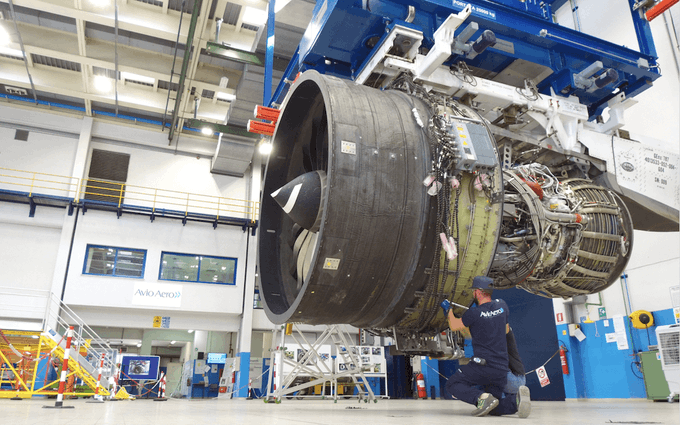エンジンメーカー各社、推力低下

機体メーカーが歩んだ道は、エンジン業界が後を追う。
過去10年の大半は、前例のないペースで旅客機のデリバリーが加速していった。それに追随すべく、ハイペースでエンジンを生産してきたエンジンメーカーだったが、そんな各社もこの1ヶ月は逆噴射状態だ。
生産ペースが落ち、場合によっては完全停止する中で、「アフターコロナ」における業界の厳しい動向予測が始まろうとしている。エアバス・ボーイング・エンブラエルの3社と、自社のサプライチェーンの中間に位置するエンジンメーカーにとって、想定されるあらゆるシナリオに暗雲が立ちこめており、その悪影響は少なくとも3つの領域において予想されている。
まず短期的には、これから数年は続くとみられる機体生産ペースに合わせ、エンジンメーカー各社は生産能力を40%以上削減する必要がある。次に、MRO(メンテナンス・修理・オーバーホール)事業による収益が激減するため、これまで長い間アフターマーケットに主眼を置いてきたビジネスモデルを見直す必要がある。
3つ目の問題は、少なくとも短期的には新型エンジンや関連技術の開発が大きく遅延するとみられることだ。これは、現状あらゆる経営資源が会社の存続のために用いられていることが理由だ。とはいえ、中長期的には、エンジン性能向上、排ガスの削減、さらなるイノベーションへの期待が戻ってくることは各社とも理解している。このため、すでに進行しているプログラムは継続されるだろうが、その開発スケジュールは遅延する可能性がある。
生産数の観点から見ると、GE Aviation社とSafran社のジョイントベンチャーであるCFM社が最大の影響を受ける。2019年に同社はアメリカとフランスの拠点の合算で1,736基のLEAP-1と391基のCFM-56-5/7を生産したが、2020年はエアバス社・ボーイング社の生産数激減に合わせ、エンジンも生産調整を強いられる。CFM社は2020年末までに2000台以上のLEAP-1も生産予定だったが、4月末に親会社の決算発表を控える今、コメントできる状況にはない。おそらく目標値は半減させることになるだろう。
GE Aviation社は、GE9Xを搭載する777-9Xプログラムや、GE90-115/GEnx-1を搭載する777-200LR/300ER、787生産の遅延により、コロナ危機以前から2020年の生産予定は控え目のものだった。しかし、アフターマーケット事業が危機に陥った今、さらなる打撃を受けようとしている。なぜなら、同社の収益の約45%をMRO事業が占めているが、それは約25%を占める軍用機やその他事業、30%を占める民間機向けのエンジン販売よりも、はるかに大きいものだからだ。
KC-46A空中給油機向けのCF6や戦闘機用エンジンなどのプログラムはこれまで通り継続される一方で、同社はすでにエンジン生産に携わる従業員の半数に4週間の一時帰休措置を取っており、損失を食い止めるための抜本的な対応を取り始めている。この対応は4月上旬に取られたものだが、3月下旬にも同社は従業員の10%(約2,500名)を削減している。これは、同社における6月末までのMRO需要が少なくとも50%は減少するという予測を受けての措置だ。
世界中の旅客機の約2/3(17,000機近く)が地上保管されている現状では、短中期的なエンジンMRO事業の見通しは悲惨なものになると言わざるを得ない。また、多くのエンジンメーカーにとって、問題はさらに複雑になる。なぜなら、アフターマーケット市場における高付加価値エンジン搭載機、特に旧世代のエアバスおよびボーイングのワイドボディ機は、少なくともこれまでのような形で再び運航されることはないと見込まれているからだ。
ロールスロイス社にとっては、この問題はさらに深刻だ。同社はこの10年ほどワイドボディ機向けマーケットに注力しており、旧世代の747・777・A330のアフターマーケット事業への依存度を増していたからだ。以前ではまったく考えられなかった、まだ比較的機齢が若いA380(トレント900を搭載)の完全退役の可能性や、RB211-535を搭載する757、トレント500を搭載するA340-600の急激な減少により、コロナ危機後のMRO需要回復に期待することができなくなっている。
同社は最低でも7.5億ポンド(9.37億ドル)の現金支出を削減することを目標に、急速に対応を進めた。これには全世界の従業員の給与10%削減や配当支払の中止が含まれている。エアバス社が発表したトレント搭載のA330neoやA350-900/1000の生産数削減や、ボーイング社が近々発表するとみられるトレント1000搭載の787生産数削減に伴うロールスロイス社製エンジンの生産調整を受けて、さらなる対応が取られるだろう。
レイセオンテクノロジーズ社の傘下に入ったプラット&ホイットニー社も、A220/A320neo向けPW1000Gの生産数削減や、アフターマーケットにおけるPW2000・PW4000・V2500向け作業の収益減により、同様の打撃を受けている。これに伴い、同社では年内を通じての10%減給、従業員の一時帰休、研究開発投資の凍結といった措置を取っている。また、ドイツのエンジンメーカーMTU社も、PW4000やCF6搭載機の早期退役により、収益に大きな影響を受けている。
以上は、Guy NorrisがAviation Dailyいた記事です。 Aviation Dailyは、民間航空に焦点を当てた経営幹部に重要な洞察をお伝えいたします。航空会社と空港の戦略、主要航空会社のデータスナップショット、運賃データ、および国際的なカバレッジを毎日お届けいたします。Aviation Dailyをもっと知りたい場合、こちらをクリックして下さい。
As the airframers go, so goes the aircraft engine industry.
After spending most of the past decade accelerating production to keep pace with unprecedented airliner delivery rates the engine makers have spent the past month in reverse thrust.
But as production lines slow, and in some cases come to a full stop, the grim guessing game about the industry’s post-COVID-19 pandemic future can begin. For every engine company, anchored midway between their own supply chains and Airbus, Boeing and Embraer in particular, all scenarios paint a bleak picture and the potential impact of the virus-triggered crisis is alarming on at least three key levels.
Near term, all must weather the storm and rapidly shrink capacity by 40% or even more to match the new realities of the slower airframe production rates now expected for the next couple of years. Second, having long since focused the core of their business models on the aftermarket, they must adjust to significantly lower revenues from a near term reduction in demand for maintenance, repair and overhaul (MRO) services.
Third, with nearly all their resources dedicated to survival, reduced revenues and spending trimmed, development of new engines and propulsion technology is expected to slow significantly—at least in the near term. However, all the manufacturers know that in the mid-to-longer term the environmental pressures on performance will return and so will the relentless demand for lower emissions and greater innovation. Already committed programs will therefore continue, albeit potentially stretched over longer test and development schedules.
From a volume perspective, GE Aviation and Safran’s CFM joint venture is expected to see the greatest change. Having delivered 1,736 LEAP-1s and 391 CFM56-5/7s in 2019, output from the combined French and U.S. operations will decline significantly in 2020 in lockstep with urgent reductions in production at Airbus and Boeing. CFM, which was previously on track towards a planned annual production rate of more than 2,000 LEAP-1s by the end of 2020, cannot comment on numbers while its parent companies remain in a dark period prior to earnings calls at the end of April, but is expected to slash this target by around half.
GE Aviation, which was already expecting a leaner 2020 before the COVID-19 pandemic because of delays to the GE9X-powered Boeing 777-9 and slow-downs to the GE90-115/GEnx-1 powered 777-200LR/300ER and 787 programs, is eyeing the even more troubling impact of the crisis on its aftermarket business. Although around a quarter of GE Aviation’s revenues come from its military and other businesses, just 30% comes from commercial engine sales. A much larger portion of its revenue—approximately 45%—comes from MRO services.
While some programs, like the CFM56 for the P-8 maritime patrol aircraft as well as military fighter engine efforts, will continue much as before, the company has already taken drastic action to stem losses by furloughing half of its engine manufacturing workers for four weeks. This move, taken in early April, followed an announcement in late March that it was reducing its workforce by 10% (around 2,500 employees), in direct response to the collapse of its MRO workload which the company estimates will be down by around 50% through mid-year at least.
However, given the exodus of around two-thirds of the world’s airline fleets into storage (almost 17,000 aircraft), the short to medium outlook for engine MRO would be described as dire at best. Compounding the issue for many of the OEMs is that the higher value aftermarket engines powering the widebody fleet, particularly the older generation Airbus and Boeing models, now look increasingly unlikely to ever return to service—at least in their existing guise.
For Rolls-Royce, this problem is particularly acute as the UK engine maker focused increasingly on the widebody market over the past decade, widening its exposure to reliance on the support revenue from aftermarket work on older fleets of 747 and 777s as well as older A330s. With full-time premature retirement a possibility, including the previously unthinkable sunsetting of relatively young Trent 900-powered A380s as well as the rapid decline of the RB211-535 powered 757 and Trent 500-powered A340-600 fleets, the company can no longer bank on the expected rebound in deferred maintenance coming out of the crisis.
Rolls has also rushed to mitigate losses by enacting measures aimed at saving at least £750 million ($937 million) in cash this year. These include a 10% salary cut for the global workforce and canceling dividend payments. Further moves are expected as the company adjusts to rate reductions announced by Airbus involving the Trent-powered A330no and A350-900/1000, as well as yet-to-be announced rate cuts for the Trent 1000-powered 787 which will shortly be revealed in detail by Boeing.
Pratt & Whitney, now part of Raytheon Technologies, is similarly impacted across the board with production of the PW1000G geared turbofan reduced for the A220/A320neo families and commercial revenues hit by falling aftermarket revenues for the PW2000/PW4000 and V2500. Measures such as 10% pay cuts through year-end, as well as furloughs, are being introduced while research and development spending is being frozen. Deliveries of military engines, in particular the F135 for the F-35 fighter and PW4000 for the KC-45A tanker remain unaffected. The early retirements of the PW4000, as well as some CF6-powered fleets, is also significantly impacting revenues for German engine maker MTU.